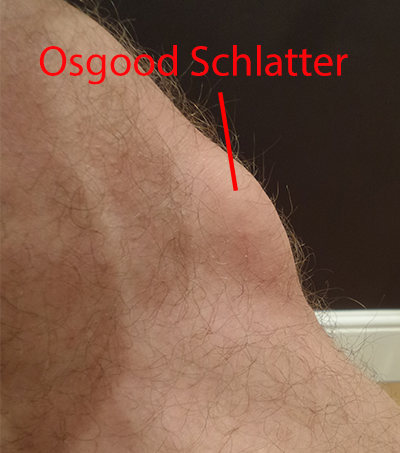Osgood–Schlatter disease (also known as apophysitis of the tibial tubercle or OSD) is an inflammation of the patella tendon at the tibial tuberosity. It is characterised by a painful lump just below the knee and most often develops in young adolescents. The pain only continues during the growth phase and will most often be pain free in adult life. The condition is named after Robert Bayley Osgood (1873–1956), an American orthopaedic surgeon, and Carl B. Schlatter (1864–1934), a Swiss surgeon who described the condition independently in 1903. It can easily be seen on xray as shown below:


Treating adults with residual ‘lumps’ following Osgood-Schlatter disease is no different than treating any other bone spur.
Treating adolescents with Osgood-Schlatters is different. In 2008 Dr Roland Hamisultane, president of the ISMST (International Society Of Medical Shockwave Treatment) stated that radial shockwave (he describes as pressure wave) should not be used for Osgood-Schlatters (amongst other problems including pseudo arthritis, osteonecrosis of the femoral head, osteochondritis and ulcers). Today more recent literature has changed this picture.
As early as 2004 Chen et al. had investigated the stimulative effect of radial SWT on the articular cartilage regeneration on 8 rabbits which were randomly assigned ino two groups, A and B. Group A was given active SWT while group B was given placebo SWT. The results suggested that regeneration of articular cartilage defect might be promoted by SWT due to the release of growth-inducing substances such as basic fibroblast growth factor, ILGF-I and TGF-β1.
More recently Lohrer et al. (2012) showed in 16 symptomatic knees, which had been resistant to other treatments, 75% of patients receiving radial shockwave hit 100 out of 100 points for recovery (75% got better). They found no side effects or long-term complications. They concluded that radial ESWT is a safe and promising treatment for adolescent athletes with recalcitrant Osgood-Schlatter disease.
Most recently, Gazya et al. (2014) clearly showed that radial ESWT (using the ShockMaster) is an effective modality to reduce pain in patients suffering with Osgood-Schlatter disease. They said it was more effective than interferential therapy and showed no side effects or complications.
It appears that the most popular method for treating Osgood-Schlatter is to use low energy at very low frequency.
Settings: Anywhere from 1.0 bar or 60mj (Gazya et al. 2014 used 0.18mj/mm2). Normally 10hz or lower (Gazya et al. used 6hz) for 2000 shocks.
Frequency: Repeated every 7-10 days. Sessions as required to eliminate the pain.